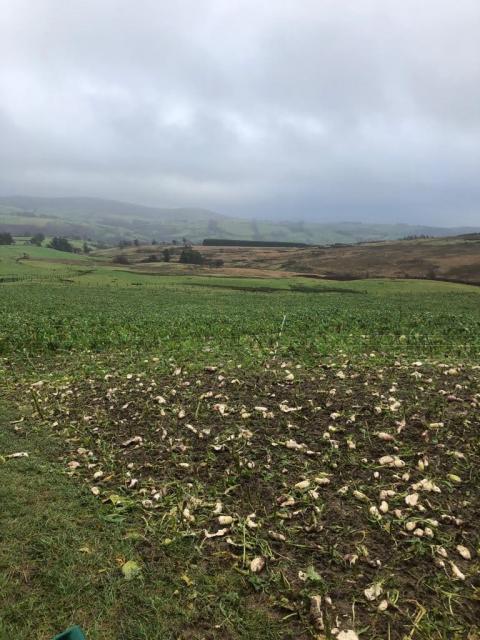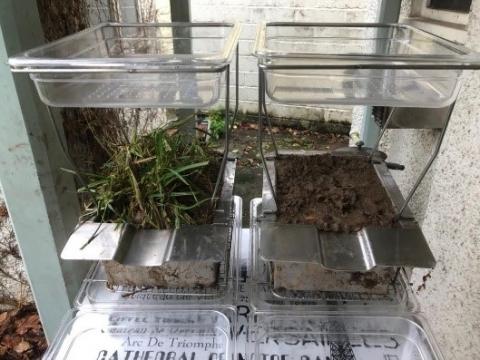Dolygarn – alterative forage options project update - October 2020-February 2021
October 2020
The main utilisation purpose of the trial fields was to finish the tail-end fat lambs in the autumn/beginning of winter, as well as keeping ewes out for longer before they are housed for lambing. Electric fencing were erected at the beginning of October, ready for 200 fat lambs to graze both crops. The Clampsaver needed to be back-fenced also to give the rape, Italian ryegrass and the clover a chance to regrow over the next few weeks/months (weather dependent). Average lamb weights are currently at 39kg. A proportion of the lambs will be weighed over the following weeks (every 2-3 weeks) before they are sent to slaughter to be able to calculate the daily liveweight gain (DLWG) and growth rates from each crop (Brassica Express vs Clampsaver). Following the lambs being sent to slaughter, the kill sheet from both crops will be compared. The Clampsaver will be available for ewes with lambs at foot to graze at turnout in the spring, with the possibility of getting a silage cut from it next summer as well.
November 2020
Lambs have now been grazing on both crops for a few weeks. As both crops are on slight slopes, ideally the crops would be strip grazed beginning at the top and working towards the bottom to avoid bare soils at the bottom of the field and nutrient and soil run-off; however, as James needs access to another field through this one, it was decided that a strip at the bottom will first of all be grazed to allow access to the other field, then the field will be grazed from the top down. Image 1. shows the utilisation from the first strip graze of the lambs. It is important not to graze the crops right down to the soil due to environmental factors.
Image 1. Utilisation from the first strip graze of the lambs
All lambs, on average, have gained 5kg as a group weight over the last 2 weeks, weighing a group average of 44kg. Grades and quality of killed lambs are predominantly E, U and R grades.
December 2020
Charlie Morgan visited Dolygarn in December,2020 to evaluate the trial fields as well as collect turf samples to be used in the rain simulators. Ground conditions on both fields on the whole are reasonable, even following the period of wet weather we’ve experienced lately. The Clampsaver field is wetter than hoped due to a few springs rising and especially wet around the gully. The Brassica Express field is not as wet, however soil conditions are poorer.
Images 2. and 3. Clampsaver field – December 2020
Image 4. Brassica Express field - December 2020
Following the visit to Dolygarn, Charlie Morgan tested the Clampsaver and Brassica Express sample of turf collected in the rain simulator, as seen in Image 5.
Image 5. Rain simulator
The results of the rain simulator can be seen in the following videos;
On 23 December, all lambs were removed from the crops, with most sold as finished lambs. 128 ewe lambs were turned onto the 4 acres of Brassica Express turnips in 2 acre breaks. 122 ewe lambs were turned onto the Clampsaver on 2 acre breaks. The grass cover on the Clampsaver measured at 2,112kgDM/ha. Yields of both crops are now similar, measuring about 6.5tDM/ha, keeping in mind that stock will be able to graze the Clampsaver again in the spring due to the re-growth of the grass and clover in the mixture.
January 2021
The establishment costs of both crops were calculated. The costs of establishing both crops were exactly the same, except for the seed costs. The area was sprayed off, received an application of pig manure and was disced and power harrowed once before seeding and rolling. The Clampsaver cost was @£44/acre, compared with £9/acre for the Brassica Express equating to £528 v £97.20, a difference of £33/acre. However, it is important to remember here that with lambs finished from the crop, as well as extra spring grass at lambing and the chance of a silage cut before reseeding the cost is well justified. The cost of creep feed for the remaining 120 lambs would be significant in itself. Importantly, the erosion of soil will be reduced from grass covered soil instead of bare ground in the wet times.
February 2021
Homemade ‘run-off catchments’ have been erected in both trial fields to help us see and evaluate any significant soil movement in both trial fields (as images 6. 7. and 8.).
Image 5. Run-off catchments in the Clampsaver field
Images 6. and 7. Run-off catchment on the Brassica Express field




